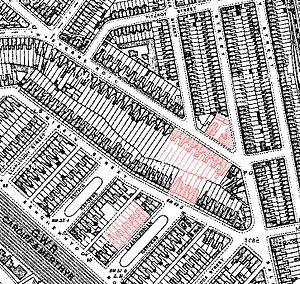Cardiff Blitz facts for kids
The Cardiff Blitz (Welsh: Blitz Caerdydd) was a series of bombings on Cardiff, Wales during World War II. From 1940 until March 1944, about 2,100 bombs hit the city. These attacks killed 355 people.
Cardiff Docks was a major target for the German Luftwaffe (air force). This was because it was one of the world's largest coal ports. Because of its importance, the docks and nearby areas were heavily bombed. Even Llandaff Cathedral was damaged during these raids in 1941.
Quick facts for kids Cardiff Blitz |
|||||||
|---|---|---|---|---|---|---|---|
| Part of the Strategic bombing campaign of World War II | |||||||
 Area of damage caused in Cathays by two parachute landmines killing 23 |
|||||||
|
|||||||
| Belligerents | |||||||
| Casualties and losses | |||||||
| Unknown | 355 | ||||||
Contents
Why Was Cardiff Bombed?
Cardiff was a very important city during World War II. Its docks were a key part of the war effort. They were used to ship coal and other supplies. This made Cardiff a target for German bombers. The goal was to disrupt supplies and lower morale.
Major Bombing Raids
Attacks in 1940 and 1941
The Luftwaffe attacked Cardiff several times in 1940. Raids happened on July 3, 10, and 12. Another attack took place on August 7. In 1941, more raids occurred on January 2, 3, and 10.
The night of January 2, 1941, saw a huge attack. Over 100 German bombers hit the city for 10 hours. The raid started at 6:37 PM. Bombers dropped high explosive bombs, incendiary bombs (fire bombs), and parachute mines. The Riverside area was hit first.
In Grangetown, a bakery was hit by a parachute mine. Thirty-two people sheltering in the basement died. After this raid, 165 people were killed and 427 injured. Nearly 350 homes were destroyed.
Llandaff Cathedral also suffered damage to its chapels and main hall. Western Cardiff was hit hardest. Areas like Canton and Riverside saw 116 deaths. About 50 people died on one street in Riverside, De Burgh Street.
More raids followed in 1941. These were on February 27, March 1, 4, 12, 20, and April 3, 12, 29, 30. Attacks continued from May 4 to 11.
The raid on April 29, 1941, was different. There were no warning flares or fire bombs. Instead, four land mines were parachuted down. They were likely meant for the Civic Centre. One landed safely in the Castle grounds. But the other three caused great harm. Ten people died in Lewis Street in Riverside. Two more mines fell in Cathays. They landed on Llanbleddian Gardens and Wyverne Road. These two mines killed 23 people. This included ten members of the Palmer family. They were in their Anderson Shelter in their garden. A nearby parish hall was destroyed. Amazingly, a Scout flag from Scott's Antarctic trip was found unharmed. Cathays Cemetery also had bomb damage.
Later Raids (1942–1944)
Fewer raids happened in 1942. Two attacks occurred on June 30 and July 2. In 1943, some of the last raids took place on May 7 and May 17–18. The May 17 raid hit the railway station. It was thought to be a response to the Dambusters' raid. A large unexploded bomb threatened to stop all train traffic.
During the very last raid, a German bomber made a mistake. It bombed Cork in Ireland, thinking the Irish Sea was the River Severn.
Images for kids
See also
- Timeline of World War II (1940)
- Cardiff Castle
- Firing Line: Cardiff Castle Museum of the Welsh Soldier


